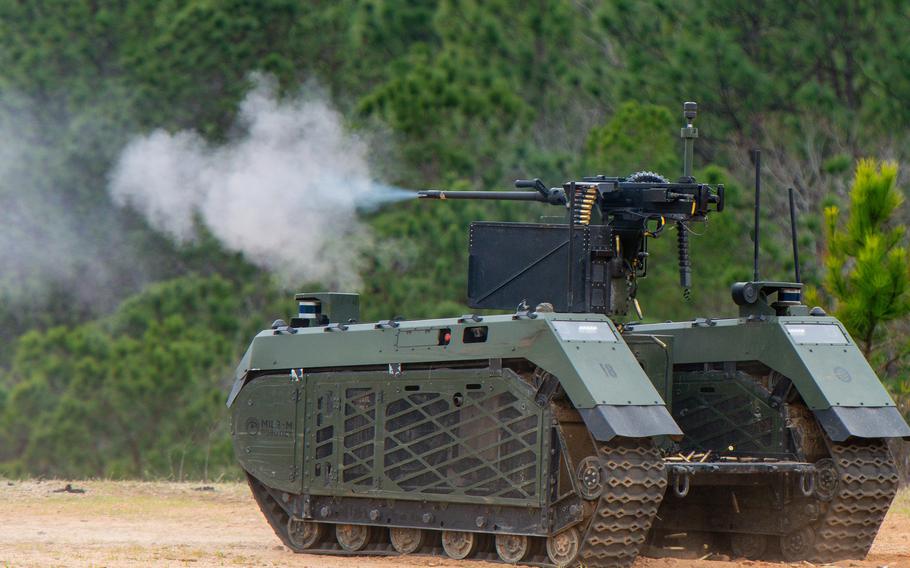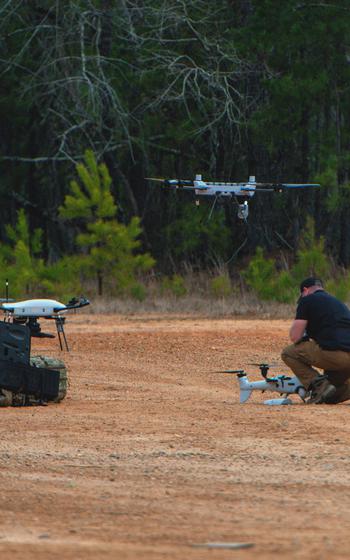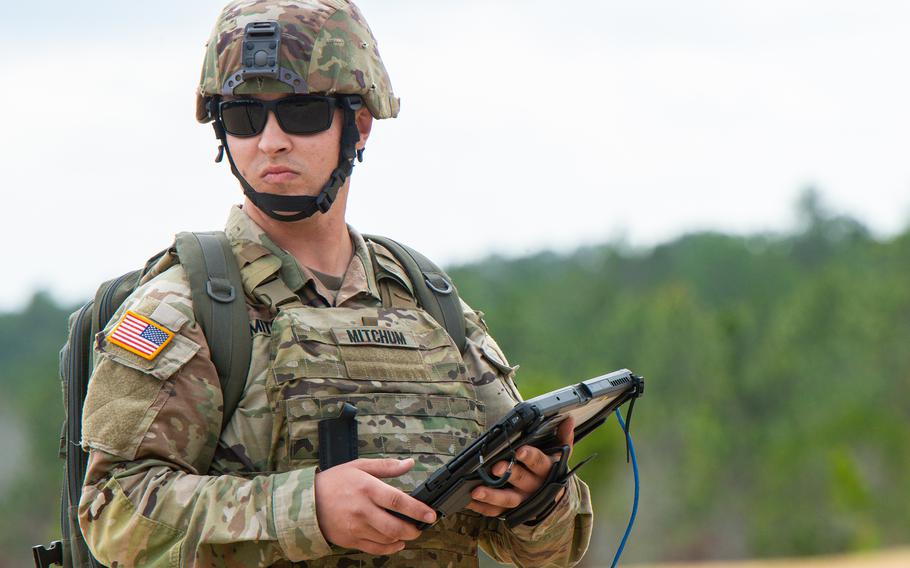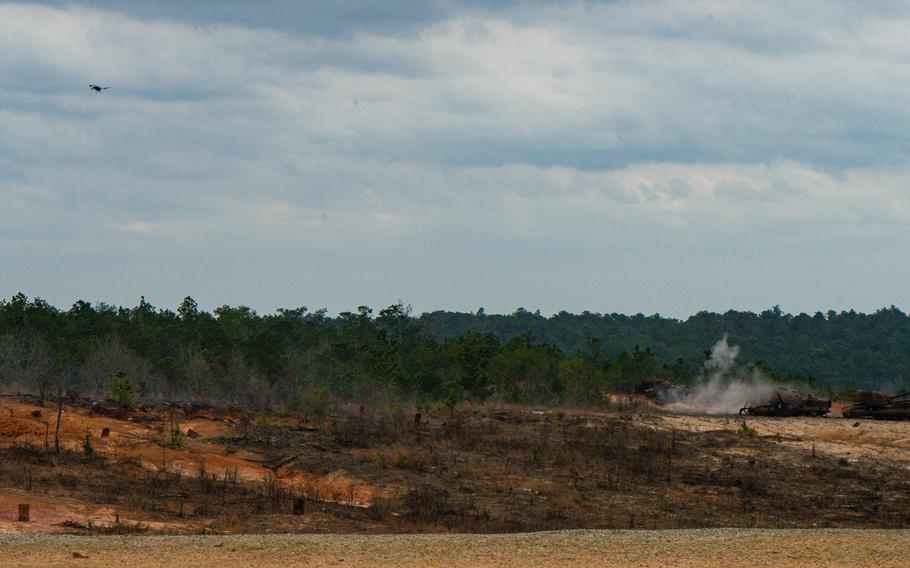
THeMIS, an uncrewed ground vehicle from the Dutch military, fires a .50-caliber machine gun during an Army Expeditionary Warfare Experiment demonstration of robotics capabilities in an infantry platoon on Tuesday, Feb. 27, 2024, at Fort Moore, Ga. The experiment is testing the viability of building robotic capabilities into light infantry platoons in the future. (Corey Dickstein/Stars and Stripes)
FORT MOORE, Ga. — A grenade exploded off in the distance, launched from a small drone hovering just over a cluster of trees on a hilly live-fire range during training last week at the Army post.
The 50-pound drone continued hovering, firing three more grenades before a ground robot outfitted with a .50-caliber machine gun moved forward, unloading automatic fire toward the direction the drone had shot. The weapons continued shooting in a scenario designed to mimic the opening salvos of a battle, as the soldiers controlling the machines remained hidden, safely out of the reach of return fire.
The drill conducted Tuesday during Fort Moore’s annual Army Expeditionary Warrior Experiment, or AEWE, demonstration is one long envisioned by military planners who hope to integrate soldier-operated machines into infantry and armor formations to keep troops safer in battle.
Infantrymen with Fort Moore’s Experimental Company have spent months conducting AEWE operations, working with aerial drones and ground robots to lead the Army’s effort of incorporating machines directly into infantry formations. They tested nearly 50 different technologies including small drones that collect intelligence or jam radio frequencies, near-silent electric motorbikes, signal-blocking camouflage materials and robots that can fire weapons or sneak up on enemy positions.
The main takeaway from the unit’s work, said Capt. Timothy Young, the Experimental Company’s commander, is the concept is sound, and at least some of the technology is nearly ready to deploy into the broader Army.
“This formation increases the lethality of infantry formations and allows commanders to have greater situational awareness early on, on the battlefield,” Young said after his soldiers conducted the live-fire demonstration. “Ground robotics … have the potential to provide direct fire and effects on the enemy beyond the [forward line of troops]. And today ground robotics are proving to be a high-payoff target for the enemy to draw indirect and direct fire away from our troops, allowing us to trade blood for machinery.”

New unmanned aerial systems are tested during an Army Expeditionary Warfare Experiment demonstration of robotics capabilities in an infantry platoon on Tuesday, Feb. 27, 2024, at Fort Moore, Ga. (Corey Dickstein/Stars and Stripes)
AEWE has tested emerging Army technology at Fort Moore for nearly two decades, said Justin Strayer, the chief of persistent experimentation for the installation’s Maneuver Battle Lab, which oversees the annual testing event. This year, Army Futures Command tasked AEWE with focusing on robotics that could be integrated into light infantry formations, Strayer said. The experiment will have similar orders next year, as the Army looks to integrate at least some of the tech being tested there into Army platoons by 2030.
AEWE is one of dozens of experimental events throughout the Army that is feeding technology into the service’s primary experimentation program, known as Project Convergence. The service will host a high-level Project Convergence demonstration this week in California at the Marines’ Camp Pendleton and the Army’s National Training Center at Fort Irwin, where it will show how some of the latest emerging technologies, including artificial intelligence capabilities, can come together to conduct major combat operations, according to the Pentagon.
Strayer said some of the work that Fort Moore’s Experimental Company has done in recent months will be tested at Project Convergence, which will also include the Defense Department’s other military services, and troops and technology from several allied countries.
On Tuesday, Experimental Company soldiers demonstrated the capabilities of nearly a dozen small drones, most weighing less than 50 pounds and capable of being toted by foot soldiers. They used several ground robots, including TheMIS — an uncrewed ground vehicle armed with a .50-caliber machine gun and provided by the Dutch military. They also used a small robot that can launch a tethered surveillance drone and carry some 2,500 pounds of gear.

A soldier with the Army’s Experimental Platoon participates in an Army Expeditionary Warfare Experiment demonstration of robotics capabilities in an infantry platoon on Tuesday, Feb. 27, 2024, at Fort Moore, Ga. (Corey Dickstein/Stars and Stripes)
While the experiments proved fruitful, they did not go without issue. During the demonstration, one drone fell out of the air and crashed, and TheMIS experienced firing issues. Young said such things are to be expected. What is clear, the captain added, is the aerial drone technology is much farther along than the ground robotics.
Some of the drones demonstrated Tuesday can perform autonomous missions, where a soldier sets a mission plan, presses a button, and the drone flies itself to look over an enemy target or search a portion of the battlefield, he said. That ability would be very beneficial to today’s platoon leaders and company commanders, Young said.
“I would dare say it’s ready to go,” he said of the semiautonomous drone technology. “The entire time [the drone flies] I know where it’s hovering, I can see what it’s looking at, and it can tell me if it finds … a human or a vehicle, which is enough to [act on].”
In some cases, the surveillance drones can find an enemy target, alert a commander via a tablet, that can then quickly relay that information to another “hunter-killer” drone to move into position and fire on the enemy. Within minutes those drones can conduct a real-time damage assessment, Young said.
“That’s a huge advantage for a commander,” he said. “And that’s why I want this air stuff [in formations] right now.”

A Cerberus GLH drone fires a 40mm grenade round during an Army Expeditionary Warfare Experiment demonstration of robotics capabilities in an infantry platoon on Tuesday, Feb. 27, 2024, at Fort Moore, Ga. (Corey Dickstein/Stars and Stripes)